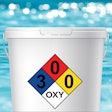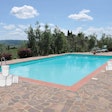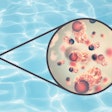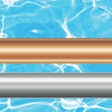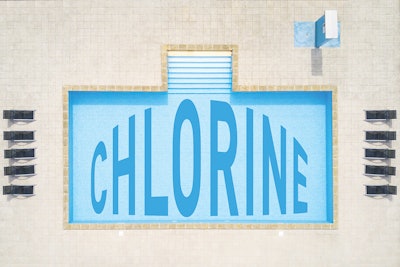
Persistent shortages and price increases of chlorine products have caused pros and consumers alike to sharpen their pencils and expand beyond typical pool treatments. Much of this has led to looking towards alternatives and devices, such as saltwater generators and the addition of secondary sanitizers, such as ozone or UV. The main concern here is to ensure that pools remain sanitized, clear, and safe through a time of supply challenges. Chlorine still remains the best way to keep pools clear and free from bacteria and algae growth, but a closer look at how chlorine works can help us find ways to use it more efficiently.
What Causes Chlorine Demand?
The first thing to address is what causes chlorine loss and ways to reduce the demand that comes from various chemicals or contaminants in the water.
Outdoor pools need stabilizer, a chemical called cyanuric acid (CYA), to protect the free chlorine FC from degradation due to UV sunlight. Unstabilized, unprotected chlorine will be consumed at a rate of 75% within two hours and completely destroyed within four hours from exposure to the sun. The addition of CYA at a level between 30 to 50 ppm will cause the FC in the pool to last eight to 10 times longer, which makes it essential for preserving chlorine in outdoor pools.
CYA level is crucial. While CYA is very beneficial at stretching chlorine in the pool water, if levels get too high it will lead to a loss of chlorine effectiveness and higher demand. Basically, this means that as CYA accumulates to higher levels, there will be a greater amount of chlorine needed in order to inactivate bacteria and algae.
How would CYA accumulate in a pool? If trichlor tablets are used as the main sanitizer, they will add CYA to the water as they dissolve. This is an initial benefit to help chlorine stay protected from the UV sunlight. However, for every 10 ppm of chlorine from trichlor tablets, there will be 6 ppm of CYA added to the water.
Unfortunately, unlike chlorine, CYA accumulates in the water and can only be reduced by either draining the pool or using chemical reducers. The best way to determine chlorine demand due to CYA accumulation is to know the FC/CYA ratio. This is a factor used to determine the amount of FC needed to keep good water quality. The desired ratio is 7.5% FC needed based on the CYA reading.
Example: 30 ppm of CYA x 7.5% = 2.25 ppm needed to keep pool water clean.
At a CYA level of 100 ppm it will take 7.5 ppm to maintain clean pool water.
As this example shows, over three times as much chlorine is needed to maintain clean pool water at 100 ppm CYA. Clearly, managing CYA levels at 30 to 50 ppm is a very important way to use chlorine efficiently.
Prevent Chloramine Formation
Combined Chlorine (CC), also called chloramine, also plays an important role in chlorine usage. When proper levels of free chlorine are in place, then whenever ammonia enters the pool, it will be oxidized and removed. If the level is not sufficient to oxidize ammonia, then the result will be chlorine combined to ammonia (CC or chloramines). This leads to less effective sanitizing and irritating chlorine odors that could be harmful to swimmers. The process of removing CC will also require more chlorine.
A good way to conserve chlorine is to maintain enough chlorine in the water to prevent CC formation. Following the 7.5% FC/CYA ratio is one way to ensure this. The addition of either a UV or ozone device helps, as both of these are excellent at inactivating the precursors that can lead to the formation of chloramines. To save chlorine, it is best not to allow CC levels to exceed 0.2 ppm and super-chlorinate or shock to remove them before they reach a maximum of 0.4 ppm. The quality of pool water and the effect and longevity of chlorine will be fantastic when combined chlorine levels remain near zero. (Side note: One of the better ways to test for the amount of CC in the pool is by the use of a FAS-DPD test kit.)
There are a couple of methods to super-chlorinate your pool to remove CC.
Method No. 1) Figure 15% of the CYA and add that amount of chlorine to the pool.
Example No. 1: 30 ppm CYA x 15% = add 4.5 ppm of chlorine.
Method No. 2) Multiply the level of combined chlorine by 10, and add that amount of chlorine to the pool.
Example No. 2: 0.4 ppm combined chlorine x 10 = add 4.0 ppm of chlorine.
In either of these scenarios, if there is a residual of free chlorine in the pool water, then it may be used to help accomplish super-chlorination. Therefore, you could subtract that amount from the chlorine you add to the pool.
Using Example No. 2: FC test shows 1.5 ppm. Subtract 1.5 from the 4.0 ppm and add 2.5 ppm. This is another secret for saving the chlorine used in shocking the pool. Many pros overdose and waste chlorine when super-chlorinating simply because they don’t know that whatever FC is present in the pool can assist in super-chlorination.
The use of a non-chlorine oxidizer MPS can also be used, and may be preferred if higher levels of chlorine will interfere with swimmers having access to the pool sooner. One pound of MPS shock oxidizer in 10,000 gallons will serve to lower CC levels.
The Effect of High TDS on Chlorine
Testing total dissolved solids (TDS) at least quarterly is important, as TDS will determine how much chlorine is needed to disinfect. Every pro should know both the TDS from the source water and the pool water. Why? Because when the TDS in the pool is 1500 ppm greater than the source water, it will take more chlorine to keep the pool sanitized.
TDS should be tested at least seasonally and maintained no more than 1500 ppm over the source water level. A simple way to maintain good TDS levels is to incorporate a regular drain and dilution practice. This could be monthly, bi-monthly, or quarterly. I do not mean an entire drain of the pool. A drain and dilute system practiced regularly can actually lead to almost never having to drain the pool entirely. Simply drain a relatively small amount, such as 2 or 3 inches, and refill. This will not only prevent the build up of solids and scale, but will also remove organic bound chloramines and lower CYA as well. It is a good practice to incorporate at least seasonally in year-round regions.
Keep Your Balance
Improper water balance will also waste chlorine. High pH and total alkalinity will lead to a weaker species of chlorine being produced — that is, the weak hypochlorite ion (ClO-), instead of the mighty killing agent hypochlorous acid (HOCl).
Powerful HOCl is 99% effective at inactivating bacteria and algae while feeble ClO- is only 1% effective. At a high pH and alkalinity, more ClO- is produced and the overall killing power of the chlorine is reduced, so you need to add more chlorine to keep the pool safe and clear. A good target pH is 7.5 and total alkalinity of 90 ppm.
Two of the biggest consumers of chlorine are nitrates and algae. One leads to the other. Have you ever noticed after a rainstorm the pool will consume a lot more chlorine? Or that it’s difficult to even reach a free chlorine reading?
One of the main culprits could be nitrates. Nitrates enter the pool in rainwater, but can also come from a heavy swimmer load that contains sweat, urine, saliva, hair care products, sunscreens, deodorant and perfume. The initial result from all this waste is the creation of nitrites.
When free chlorine is at the proper level of 7.5% of CYA, nitrites can be oxidized and removed, and chlorine will be able to sanitize better and longer. If the FC level is too low, the nitrites will not oxidize and then will convert to nitrates. Once nitrates build up, they cannot be removed chemically. The only way to lower nitrates is to drain some of the water. If nitrates are present at 10 ppm or above, the chlorine demand will be higher.
Food For Algae
Nitrates and phosphates both fuel algae growth. They are plant fertilizers and algae is a plant. When there are higher levels of phosphates or nitrates, any algae present in a spore form will begin to feed. The very act of algae feeding will consume more chlorine than normal. In this scenario, it is not the nitrates or the phosphate that are directly taking chlorine; it is the feeding process of the algae that creates the high demand.
Another way algae feeds itself is by photosynthesis. This is a process where algae utilizes the sunlight to produce glucose for strength and sustenance. Large amounts of chlorine will be consumed during this process. The best case for chlorine conservation is to establish a routine that removes any opportunity for algae to feed and begin to bloom. This includes proper chlorine ratio, regular and thorough brushing of all surfaces, proper filtration and circulation, phosphate and nitrate removal, and a good preventative algaecide. A proactive algae regime will save on chlorine use; a reactive one may find you dealing with algae blooms in the pool that will suck up lots of chlorine.
Borates also help; they are excellent at stunting the growth of algae. Borate disrupts the blooming phase of algae at the cellular level and acts as an algaestat. Avoiding an algae bloom, of course, can save a lot of chlorine. It should be noted that borate is not an algaecide and will not kill existing algae. Another way that borate improves the effectiveness and longevity of chlorine is by softening the water. Soft water allows for chemicals to function and be dispersed better than in hard water. When it comes to the CYA/FC ratio of 7.5%, with borate at 50 ppm, the ratio is lowered to 5%, so less chlorine is needed to achieve good disinfection and oxidation.
Example:
Borates 50 ppm
CYA 30 ppm x 5% = 1.5 ppm FC needed to keep pool clear and clean (as opposed to 2.25 ppm FC without borates).
Borates also help increase the effectiveness of chlorine because they act as a buffer to keep the pH from rising. Remember, water with high pH produces less HOCl, the stout, strapping killing agent from chlorine.
Borates can also be a very helpful agent in pools with saltwater generator systems and the more modern pools with negative edges, waterfalls and raised hot tubs. All of these features create more turbulence and aeration of the water, thus the pH has a tendency to rise. Borates help to slow this natural pH raise and thus, allow for less acid use.
Water Chemistry Targets to Help Chlorine Last Longer
Here are some recommended targets to aim for in pool water that greatly improve the quality and longevity of chlorine.
pH: 7.5
Total alkalinity: 90 ppm
Calcium hardness:
- 350 ppm (plaster or cementitious surfaces)
- 250 ppm (fiberglass or vinyl surfaces)
Cyanuric Acid (CYA): 50 ppm
Borates: 50 ppm
Total Dissolved Solids (TDS): 1500 ppm over fill source water
(It should be noted that these targets are all close or within the range of the Pool & Hot Tub Alliance’s recommended ideal guidelines.)
Conserving chlorine and getting the most for your money takes creating a system where pool water quality is sustained, and the water is more predictable. By managing CYA, keeping the proper dose of free chlorine, controlling TDS, and adding borates, you can help ease the chlorine shortage and keep your customers’ water clean and clear at a reasonable cost.
Terry Arko has over 40 years of experience in the pool, spa and hot tub industry, working in service, repair, retail sales, chemical manufacturing and product development. He is a CPO instructor through the National Swimming Pool Foundation. He also serves as instructor for the Pool Chemistry Training Institute to certify residential pool techs. Terry is an active member on the PHTA Recreational Water and Air Quality Committee (RWAQC). He currently works for HASA.
This article first appeared in the November 2022 issue of AQUA Magazine — the top resource for retailers, builders and service pros in the pool and spa industry. Subscriptions to the print magazine are free to all industry professionals. Click here to subscribe.





























